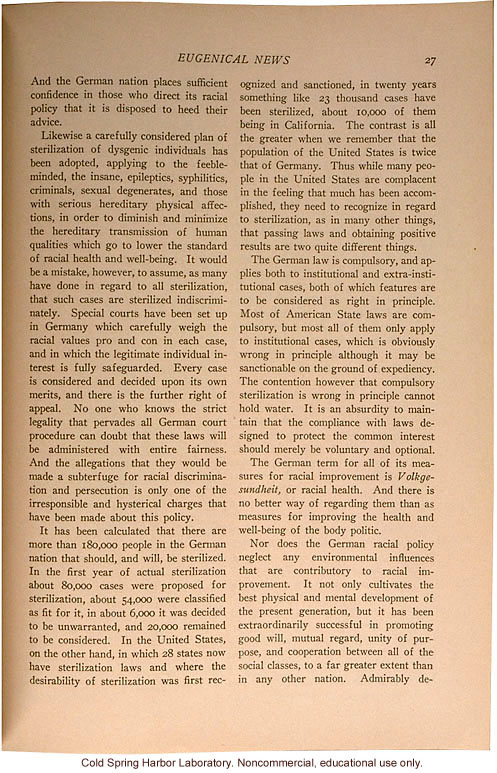Eugenical News 27
And the German nation places sufficient confidence in those who direct its racial policy that it is disposed to heed their advice.
Likewise a carefully considered plan of sterilization of dysgenic individuals has been adopted, applying to the feeble-minded, the insane, epileptics, syphilitics, criminals, sexual degenerates, and those with serious hereditary physical affections, in order to diminish and minimize the hereditary transmission of human qualities which go to lower the standard of racial health and well-being. It would be a mistake, however, to assume, as many have done in regard to all sterilization, that such cases are sterilized indiscriminately. Special courts have been set up in Germany which carefully weigh the racial values pro and con in each case, and in which the legitimate individual interest is fully safeguarded. Every case is considered and decided upon its own merits, and there is further the right of appeal. No one who knows the strict legality that pervades all German court procedure can doubt that these laws will be administered with entire fairness. And the allegations that they would be made a subterfuge for racial discrimination and persecution is only one of the irresponsible and hysterical charges that have been made about this policy.
It has been calculated that there are more than 180,000 people in the German nation that should, and will, be sterilized. In the first year of actual sterilization about 80,000 cases were proposed for sterilization, about 54,000 were classified as fit for it, in about 6,000 it was decided to be unwarranted, and 20,000 remained to be considered. In the United States, on the other hand, in which 28 states now have sterilization laws and where the desirability of sterilization was first recognized and sanctioned, in twenty years something like 23 thousand cases have been sterilized, about 10,000 of them in California. The contrast is all the greater when we remember that the population of the United States is twice that of Germany. Thus while many people in the United States are complacent in the feeling that much has been accomplished, they need to recognize in regard to sterilization, as in many other things, that passing laws and obtaining positive results are two quite different things.
The German law is compulsory, and applies to both institutional and extra-institutional cases, both of which features are to be considered as right in principle. Most of American state laws are compulsory, but most all of them apply only to institutional cases, which is obviously wrong in principle although it may be sanctionable on the ground of expediency. The contention however that compulsory sterilization is wrong in principle cannot hold water. It is an absurdity to maintain that the compliance with laws designed to protect the common interest should merely be voluntary and optional.
The German term for all of its measures for racial improvement is [italics]Volkgesundheit,[end italics] or racial health. And there is no better way of regarding them than as measures for improving the health and well-being of the body politic.
Nor does the German racial policy neglect any environmental influences that are contributory to racial improvement. It not only cultivates the best physical and mental development of the present generation, but it has been extraordinarily successful in promoting good will, mutual regard, unity of purpose, and cooperation between all of the social classes, to a far greater extent than in any other nation. Admirably de-
[end]


